| |
|

|
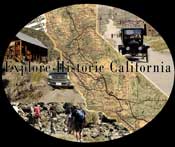
Visit our
Explore Historic California
site on
Facebook
|
CERRO
GORDO UPDATE
7/23/12 |
|
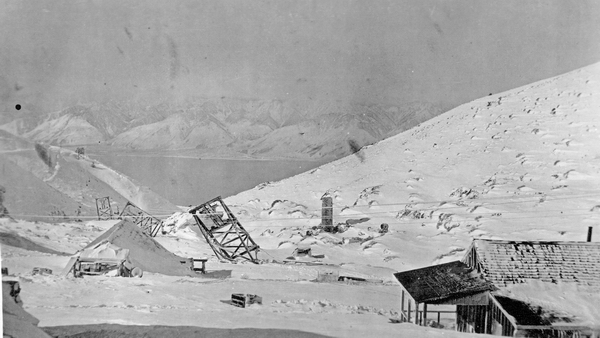 |
|
Cerro Gordo
officially
CLOSED to VISITORS
as of July 25, 2012
Please phone
Sean Patterson (661-303-3692) or Cerro Gordo (760-876-5030)
for additional information.
Caretakers are still on
site to prevent vandalism.
Contact us through email at:
 |
|
|
 |
|
Friends of Bodie
Day 2013
Sat., August 10, 2013.
Click on the poster above
for more information. |
|
|
|
|
Now Available
Cerro Gordo
A
Ghost Town
Caught Between
Centuries |
|
 |
|
Cecile
Page Vargo's collection of Cerro Gordo stories, true, farce
and somewhere in between, is being published in a new book,
Cerro Gordo A Ghost Town Caught Between Centuries.
ISBN: 978-0970025869
The book
gives glimpses of Cerro Gordo from the silver and lead
mining days through the early twentieth century zinc era to
its modern place as, according to author Phil Varney,
"Southern California's best, true, ghost town." There's even
a possible solution to the location of the fabled "Lost
Gunsight
Mine" that former Cerro Gordo owner Mike Patterson
once suggested.
We are
proud to team with the Historical Society of the Upper
Mojave Desert (HSUMD) in Ridgecrest, Calif., to bring Cerro Gordo
A Ghost Town Caught Between Centuries to print. This is
their first major publishing venture. The book is
available for sale directly from HSUMD or through selected
book sellers.
Contact
HSUMD directly to order:
P.O. Box 2001, Ridgecrest, CA. 93556-2001.
Phone: 760 375-8456
Email: hsumd@ridgenet.net
Announcing our Arcadia Publishing Book:
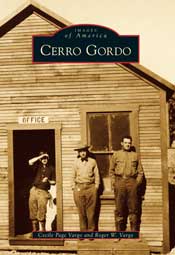
Cerro Gordo
by
Cecile
Page Vargo and Roger W. Vargo
ISBN: 9780738595207
Arcadia Publishing Images of
America series
Price: $21.99
128 pages/ softcover
Available
now!
(Click the cover image for ordering information)
Available
at area bookstores, independent retailers, and
online retailers, or through Arcadia Publishing at
(888)-313-2665 or
online.
|
|
|
 |
|
 |
|
Mules can
taste the difference--so can you |
|
 |
 |
|
Friends
of Last Chance Canyon is a new organization interested in
sustaining and protecting areas within the El Paso
Mountains, near Ridgecrest, California. The main focus is
preserving and protecting historic sites like Burro
Schmidt's tunnel and the Walt Bickel Camp.
Please click
on either logo to visit the FLCC site. |
|
|
We
support |
|
 |
|
|

Bodie Foundation
"Protecting Bodie's Future by Preserving Its Past |
|
|
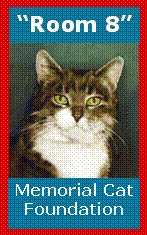 |
|
|
|
Click on Room 8's
photo or phone
951-361-2205
for more information. |
|
|
 |
|
The Panamint Breeze is a newsletter for people who
love the rough and rugged deserts and mountains of
California and beyond.
Published by Ruth and Emmett Harder, it is for people who
are interested in the history of mining in the western
states; and the people who had the fortitude to withstand
the harsh elements.
It contains stories of the past and the present; stories of
mining towns and the colorful residents who lived in them;
and of present day adventurers.
Subscriptions are $20 per year (published quarterly –
March, June, September & December) Subscriptions outside the
USA are $25 per year. All previous issues are available.
Gift certificates are available also.
To subscribe mail check (made payable to Real Adventure
Publishing) along with name, address, phone number & e-mail
address to: Real Adventure Publishing, 18201 Muriel Avenue,
San Bernardino, CA 92407.
For more information about the
Panamint Breeze e-mail Ruth at: echco@msn.com |
|
|
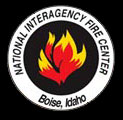 |
|
It's always FIRE
SEASON! Click the NIFC logo above to see what's burning. |
|
|
 |
|
Visit Michael
Piatt's site,
www.bodiehistory.com, for the truth behind some of
Bodie's myths. |
|
|

Credo Quia Absurdum |
|
Explore Historic California! |
|
Not too many years ago, the family station wagon was the
magic carpet to adventure. Today, that family station wagon is likely to
be a four wheel drive sport utility vehicle or pick up truck. SUV's and
other 4x4's are one of the best selling classes of vehicles. Ironically,
industry statistics show that once purchased, few owners will dare to
drive their vehicles off the paved highway.
Click your mouse through
the
website and enjoy our armchair adventures and the histories behind them.
|
|
Mono Mills to Bodie
By Robert C. Likes
|
In honor
of the "Railroad in the Sky" theme for the 2013
Friends of Bodie Day (August 10, 2013), we are rerunning
this story on the Bodie Railroad by the late Robert C.
Likes. We originally published it in May, 2006.

Situated in a tranquil setting on the desert side of the
Sierra Nevada
,
Mono
Lake
has been
referred to as “the Dead Sea of America.” This large brackish
body of water contains a high percentage of sodium sulphate, two
small islands, no marine life, and very little vegetation on its
shoreline. The soil of the surrounding terrain is largely volcanic
sand and pumice which barely supports the growth of sagebrush, and
in places, is devoid of any growth.
The paradox to this picture is the forests of Jeffrey and
lodgepole pine a few miles south of Mono
Lake. It is
surprising that this country could bear trees, and incredible that
they would mature to four feet in diameter. However, the country
does, and the trees did, and therein lies the birth of a railroad.
|
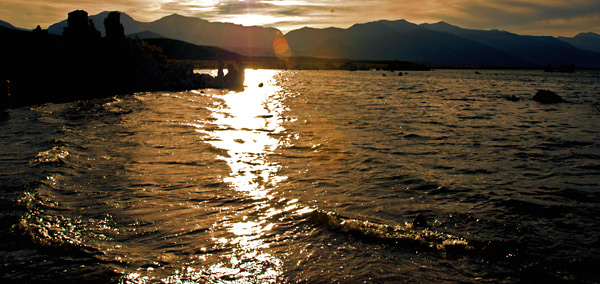
|
|
Mono
Lake at sunset looking west to the Sierra Nevada Mountains. |
Huddled in the sagebrush-covered mountain, 30 miles north of Mono
Lake, was the
brawling, boisterous, gold mining town of Bodie, California. With a soaring
population of nearly 12,000, the town’s need for lumber to build
homes, timber for shoring mines, and wood for fuel was tremendous.
teamsters could not begin to meet the enormous appetite Bodie had
for consuming wood. The stage was set for the obvious answer to the
problem - build a railroad to the large timber stands south of Mono
Lake
.
|

|
|
Bodie,
California as seen from the cemetery. |
The Bodie Railway and Lumber Co. was organized on February
18, 1881, and shortly afterwards, J. T. Oliver surveyed the route
from Bodie to the mill site five miles south of Mono Lake.
When completed, the proposed 31.7 miles of roadbed was to
descend the 2,000 foot drop in elevation and traverse the alkali
flats on the eastern shore of Mono
Lake. Thomas Holt, an
engineer, was selected to ramrod the project. In addition to this
task, Holt was operating a five-ton steamship and several barges on
which materials and supplies were transported across Mono
Lake
to the railroad
construction crews.
While the sawmill was being built, grading for the roadbed
was started at the top of Bodie Bluff in May, 1881. With the aid of
two switchbacks, many cuts, and a 260-foot trestle, the steep and
circuitous grade down to lake elevation was accomplished, and by
mid-July, the first 20 miles of roadbed had been graded.
The first shipment of rails arrived in August, and as they
were being spiked into place, the final five miles of grading was
completed to the new mill. In all, some 2,00 tons of rails, spikes
and other supplies were used. The total cost of the road reached
$450,931. In addition, $81,390 was spent for equipment that included
4 engines, 12 service cars, 51 flat cars, and one caboose. The
“last spike” was driven on
November 14, 1881
, and a two-car
lumber train arrived afterwards to officially open the road.
The following weeks saw the new railway quite active with a
scheduled train leaving Bodie each day at
6:30 A.M.
and arriving at
Mono Mills at
10:00 A.M.
The train
departed the mill at
2 o’clock
each afternoon,
and arrived back at Bodie by
6:00 P.M.
The ten - to
twelve-car train was broken up into three sections prior to the
final approach to Bodie in order to negotiate the switchbacks and
3.8% grades. In addition to the problems caused by the sharp turns
and steep grades, the rolling stock was not equipped with air rakes.
Two brakemen were kept busy hopping from car to car setting the hand
brakes whenever the train began to gain momentum. There were many
derailments, but no fatalities among the crewmen were ever recorded.
The southern terminus at Mono Mills, while not a large
settlement, was a busy one. There were 200 men employed in the wood
and lumber business, and the aroma of fresh sawdust was everywhere.
Two large boarding houses and six smaller dwellings were located
near the mill. The single store supplied all the necessary goods
required by the residents, and was operated by Gilchrist, Sharp
& Company, who also had 40 mules packing wood, and two large ox
teams hauling lots to the mill.
|
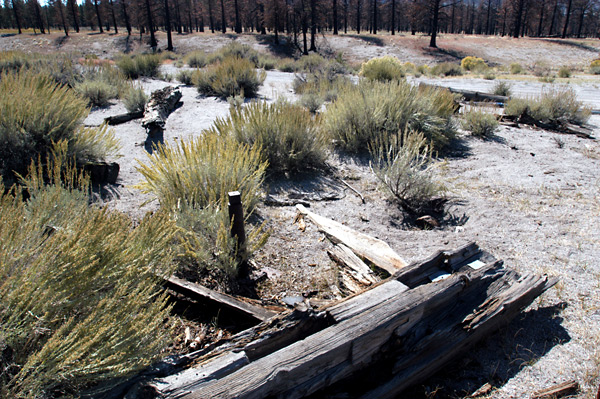
|
|
Remains
of structures at Mono Mills today. |
The well equipped mill was one of the best in the state.
Located in a small ravine, the second floor was level with the
surrounding country so the heavy logs could be easily rolled into
the mill where 54 inch circular saws quickly reduced their size. One
44 inch “pony” and two smaller cut off saws completed the task
of transforming logs to lumber. The machinery was powered by a steam
engine, and water was obtained from springs and transported to the
mill by 2-inch pipe. The mill had the capacity for turning out
80,000 board feet every ten hours.
|
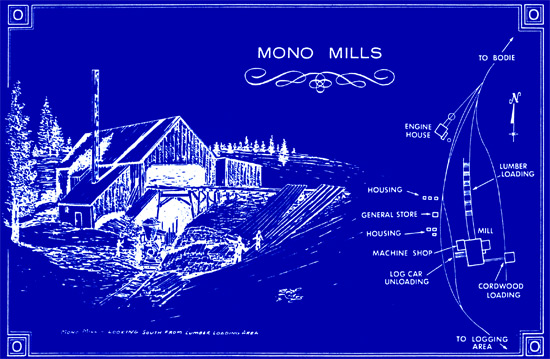
|
|
Drawing
of Mono Mills and Bodie RR trackage by Robert C. Likes. |
The greatest portion of Mono Mills output was in cordwood.
This relatively poor quality of wood was used as fuel to produce
steam power for the hoists and stamp mills at the Bodie mines. This
demand kept the flat cars loaded to capacity and helped offset the
low yield of only 8,000 board feet per acre for construction lumber.
The “last run” of the season was made on
January 7, 188, after which the
railroad closed down for the winter.
While the snow covered all traces of the railroad, is board
of directors were evaluating the future. It was decided that
conditions were good enough to start expanding. A new line was to be
graded into
Benton ,
California, with hopes of
connecting to the forthcoming Carson & Colorado narrow gauge.
With this connection to the outside world in mind, the name of the
railway was changed to the Bodie & Benton Railway &
Commercial Co., and the following spring brought renewed activity.
On
May 12, 1882
, grading for the
“Benton Branch” began at the Warm Springs station, midway
between Bodie and mono Mills. During the same month, four more miles
of track was added south of the sawmill to help facilitate the
logging operation. Turntables were installed at both Bodie &
Mono Mills. During he same month, four more miles of track was added
south of the sawmill to help facilitate the logging operation.
Turntables were installed at both Bodie and Mono Mills. They were the
Armstrong “gallows” type, and required man-power to “walk”
the engines around.
After nine miles of grading through Adobe meadows had been
completed, work on the Benton
extension was
suddenly called to a halt. Although no reason was given at the time,
it could have well been an early warning of future conditions, for
toward the winter months of 1882 and during 1883, many of the mines
at Bodie closed down, and the railroad was operating only
intermittently. The entire railroad, including the timber acreage
and sawmill, was leased in 1884, and for the next six years operated
on “as required” basis only. by 1890, conditions at Bodie
reached a low ebb, and the railroad was inactive for three years.
Tom Legett, superintendent of Bodie’s biggest producer, the
Standard mine, convinced the owners that electric power would
greatly reduce their operating costs. Since Bodie did not have a
stream n which to base a power plant, the Standard Mine purchased
the necessary ground on Green Creek, fourteen miles away. Although
crude by today’s standards, the Greek Creek plant would develop
6,5000 volts and was the “shot in t” Bodie needed to get back on
its feet. In 1893, Legett turned on the main switch and the electric
motors at the Standard Mine began humming.
The sleeping town of
Bodie
woke with a
shout, and once again the railroad was doing business as usual. Two
years later, a new cyanide process was developed to recover gold
from the huge mounds of tailings formerly thought worthless. This
operation further aroused activity in the area and nine such plants
were constructed in short order. By the turn of the century,
Bodie’s population had leveled off at 500, and mining activity
became steady without the ups and down of the “boom years.”
Charles Knox of Tonopah,
Nevada, and Jim Cain of
Bodie, formed a syndicate to purchase the railroad in 1906. This
time the railway was doing business under the name of The Mono Lake
Railway & Lumber
Co.
The new company
acquired additional timber lands, bringing their holdings to 23,000
acres. The stockholders expected to do a flourishing business as
contracts for large quantities of wood and lumber were already
signed. Many propositions for an outside rail connection were made
over the next few years, but the only rail expansion was more
trackage into the woods.
Mining activity in Bodie suffered a steady decline after
1912. The granddaddy of them all, the Standard Mine, closed down in
1914 after contributing to an estimated 90 million dollars in gold
extracted from the district. By 1916, the population of Bodie had
decreased to 200, and it was becoming apparent that the town was
soon to join the ever-increasing list of “ghost towns.”
The story of Bodie’s narrow gauge to nowhere came to end in
1917, when the railroad was sold for scrap. The town that the
B&B Railway helped build is today preserved as a California
State
Historic
Park. On a hill
overlooking this relic of California’s bonanza era,
stands the old railroad station, a weathered marker for this chapter
in the fabulous history of narrow gauge railroads.
|
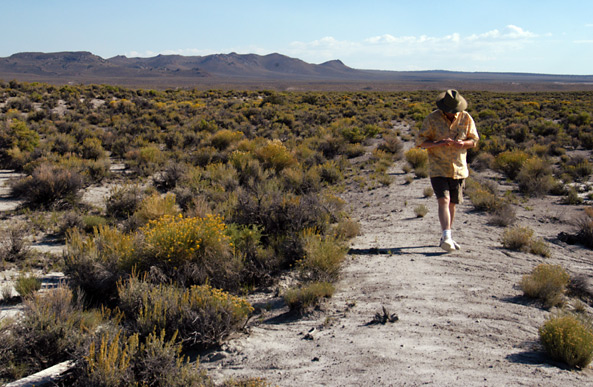
|
|
An
explorer walks the berm of the Bodie RR. View looking to the
south. |
About
this Article
This
article was originally published in Desert Magazine in the
1970’s and is reprinted with permission of Robert C. Likes. Robert
is the author, along with Glenn R. Day, of From this
Mountain--Cerro Gordo.
Thanks
also go to David A. Wright of Great Basin Research, who located a
copy of the article in his private collection, and sent it to us.
You can
read more about the Bodie Railway on David’s website
http://www.gbr.4wdtrips.net/railroads/bbrr2.htm
|
|
|
|
|
|
|
|
|
A Year
in Bodie
A new book
by former Bodie Ranger Carl Chavez
|
|
Carl Chavez, a
ranger in the early days of Bodie State Historic Park, has
written a new book (with his wife Margaret) detailing a year
(1966-1967) of his life in Bodie. The book is entitled A
Year in Bodie 1966-1967. This is Carl's second book. His
first book, A Pathway Through Parks, detailed Carl's
life as a ranger in the California State Parks system,
including in stay in Bodie. |
|
 |
 |
|
Carl Chavez
one one of the speakers at the 2012 Friends of Bodie event
that celebrated the park's 50th anniversary as a part of the
California State Park system. With Carl are Bodie Foundation
President Brad Sturdivent and Marilyn Linkem, District
Superintendant. |
|
 |
|
|
|
|
|
|
|
|
|
|
|
|
|
|
|
| |
|
|
|
|
|
|
|
|
| |
|
|
| |
|
|
|
|
|
|
|
|
